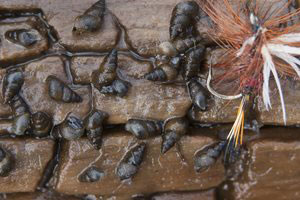 Recently the Wyoming Game and Fish Department announced the spread of New Zealand Mudsnails into the Salt River south of Alpine (dammit) and the North Platte River near Casper, read their press release from the 22nd here.
Recently the Wyoming Game and Fish Department announced the spread of New Zealand Mudsnails into the Salt River south of Alpine (dammit) and the North Platte River near Casper, read their press release from the 22nd here.
From the post (emphasis mine) –
The Wyoming Game and Fish Department recently confirmed new findings of New Zealand mudsnails in both the North Platte River near Casper and the Salt River south of Alpine. New Zealand mudsnails are an aquatic invasive species (AIS) that have spread throughout the Greater Yellowstone Ecosystem and now persist in several water bodies in the northwest part of the state, but this is the first finding on the North Platte River.
New Zealand mudsnails are non-native snails that pose some issues for fisheries. They can alter water chemistry through filter feeding and reproduce at rapid rates. They crowd out habitat suited for stoneflies, caddisflies and other insects that are important food for trout. The New Zealand mudsnail is able to shield itself from toxins in the water, making chemical eradication of the species impossible.
“New Zealand mudsnails are easily transported on waders and drift boats. Not taking the time to Clean, Drain, Dry between waters likely led to these new infestations,” states Eric Hansen, Game and Fish AIS specialist in Casper.
While the Game and Fish AIS program focuses on intercepting invasive species like zebra and quagga mussels from out of state, this is a good reminder for water users traveling to different waters within Wyoming that they must also Clean, Drain and Dry to prevent moving harmful species like New Zealand mudsnails and curly pondweed.
Hansen adds, “Complacency will not prevent the further spread of these damaging organisms. It will take action, concern, and care for our fisheries and recreation waters to stop an even more rapid escalation of invasive species in the future. Realizing that a simple task like cleaning your equipment, draining all standing water no matter how minimal and drying everything after each use will help exponentially in slowing the progress of these unwanted, water spoiling invaders.”
While some argue the spread was inevitable, cleaning and drying gear between uses is an essential, and damned simple to do. Just do it.
Here’s the WY Game and Fish Dept’s info sheet on the critters, note the distribution map is obviously out of date.
Image above via WY Game and Fish, image below via the article on the spread from the Jackson Hole News and Guide.

